
The simulation Sal mentions in the video can be found directly following this video in the lesson.
- Subject:
- Astronomy
- Physical Science
- Material Type:
- Lesson
- Provider:
- Khan Academy
- Provider Set:
- Khan Academy
- Author:
- Sal Khan
- Date Added:
- 12/07/2012

The simulation Sal mentions in the video can be found directly following this video in the lesson.

" This course covers the fundamentals of astrodynamics, focusing on the two-body orbital initial-value and boundary-value problems with applications to space vehicle navigation and guidance for lunar and planetary missions, including both powered flight and midcourse maneuvers. Other topics include celestial mechanics, Kepler's problem, Lambert's problem, orbit determination, multi-body methods, mission planning, and recursive algorithms for space navigation. Selected applications from the Apollo, Space Shuttle, and Mars exploration programs are also discussed."

Astronomy is designed to meet the scope and sequence requirements of one- or two-semester introductory astronomy courses. The book begins with relevant scientific fundamentals and progresses through an exploration of the solar system, stars, galaxies, and cosmology. The Astronomy textbook builds student understanding through the use of relevant analogies, clear and non-technical explanations, and rich illustrations. Mathematics is included in a flexible manner to meet the needs of individual instructors.
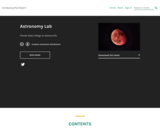
This lab book is written to accompany an introductory astronomy course.
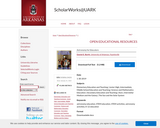
Astronomy for Educators provides new and accomplished K-12 instructors with concepts and projects for low-cost, high-impact STEM classroom instruction that is built around the National Academies National Research Council's K-12 Framework for Science Education.

Intended for all audiences, this textbook is an introduction to the nature of the universe. Use it to research or review our solar system, stars, galaxies, and the history of the universe. Each chapter has a set of corresponding homework questions.
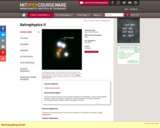
Galactic dynamics: potential theory, orbits, collisionless Boltzmann equation, etc. Galaxy interactions. Groups and clusters; dark matter. Intergalactic medium; x-ray clusters. Active galactic nuclei: unified models, black hole accretion, radio and optical jets, etc. Homogeneity and isotropy, redshift, galaxy distance ladder. Newtonian cosmology. Roberston-Walker models and cosmography. Early universe, primordial nucleosynthesis, recombination. Cosmic microwave background radiation. Large-scale structure, galaxy formation.
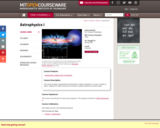
Size and time scales. Historical astronomy. Astronomical instrumentation. Stars: spectra and classification. Stellar structure equations and survey of stellar evolution. Stellar oscillations. Degenerate and collapsed stars; radio pulsars. Interacting binary systems; accretion disks, x-ray sources. Gravitational lenses; dark matter. Interstellar medium: HII regions, supernova remnants, molecular clouds, dust; radiative transfer; Jeans' mass; star formation. High-energy astrophysics: Compton scattering, bremsstrahlung, synchrotron radiation, cosmic rays. Galactic stellar distributions and populations; Oort constants; Oort limit; and globular clusters.
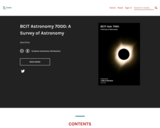
This edition of the OpenStax Astronomy text has been edited by Douglas College’s Jennifer Kirkey (to whom my thanks go for help in transitioning to OpenStax) to include references to Canadian astronomers as well as the contributions of our First Nations. I am open to your comments and suggestions regarding the textbook. Because it is open source, it can be edited and updated to suit your needs and wishes.
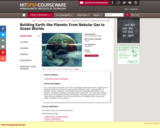
" This course covers examination of the state of knowledge of planetary formation, beginning with planetary nebulas and continuing through accretion (from gas, to dust, to planetesimals, to planetary embryos, to planets). It also includes processes of planetary differentiation, crust formation, atmospheric degassing, and surface water condensation. This course has integrated discussions of compositional and physical processes, based upon observations from our solar system and from exoplanets. Focus on terrestrial (rocky and metallic) planets, though more volatile-rich bodies are also examined."

This resource describes the full set of lecture slides available in this linked Google Drive folder. The slides are based on OpenStax Astronomy and are designed for a 14-week course. Lecture Videos that use these slides will be available as a separate posted resource.
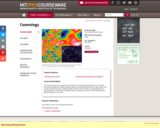
Thermal backgrounds in space. Cosmological principle and its consequences: Newtonian cosmology and types of "universes"; survey of relativistic cosmology; horizons. Overview of evolution in cosmology; radiation and element synthesis; physical models of the "early stages." Formation of large-scale structure to variability of physical laws. First and last states. Some knowledge of relativity expected. 8.962 recommended though not required. This course provides an overview of astrophysical cosmology with emphasis on the Cosmic Microwave Background (CMB) radiation, galaxies and related phenomena at high redshift, and cosmic structure formation. Additional topics include cosmic inflation, nucleosynthesis and baryosynthesis, quasar (QSO) absorption lines, and gamma-ray bursts. Some background in general relativity is assumed.
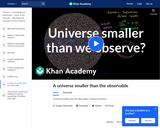
This 9-minute video lesson considers various theories about the size of the universe. [Cosmology and Astronomy playlist: Lesson 19 of 85]

This 7-minute video lesson looks at apsidal precession (Perihelion Precession) and Milankovitch Cycles. [Cosmology and Astronomy playlist: Lesson 75 of 85]
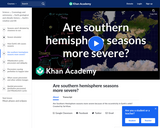
This 7-minute video lesson addresses the question: Are southern hemisphere seasons more severe because of the eccentricity in Earth's orbit? [Cosmology and Astronomy playlist: Lesson 72 of 85]

This 11-minute video lesson looks at the process of a star becoming a red giant. [Cosmology and Astronomy playlist: Lesson 17 of 85]
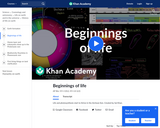
This 10-minute video lesson looks at the beginnings of life on Earth. Life and photosynthesis start to thrive in the Archean Eon. [Cosmology and Astronomy playlist: Lesson 39 of 85]

This 10-minute video lesson contiues to discuss the beginnings of life on Earth. The ozone layer and eukaryotes show up in the proterozoic eon. It includes the great oxygenation event (oxygen catastrophe). [Cosmology and Astronomy playlist: Lesson 40 of 85]

This 10-minute video lesson continues to discuss the beginnings of life on Earth. It looks at the Cambrian explosion and biodiversity in the Phanerozoic Eon. [Cosmology and Astronomy playlist: Lesson 41 of 85]

This 6-minute clarifies the first living things to colonize land. [Cosmology and Astronomy playlist: Lesson 42 of 85]